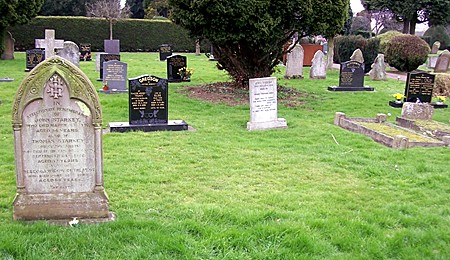|
Unmarked graves
One of the puzzling features of the town cemetery for many people is the vacant land between some of the tombstones in the older section of the burial ground. Most of the area is covered with decaying stone memorials but some of the rows are punctuated by grassy spaces and it is widely believed that they are an indication of empty plots. This is not so. The cemetery was opened in 1855 and the Victorians were noted for their methodical approach to all matters and so it is unlikely that a single inch of ground would be wasted, each interment close upon the next and all laid out in measured rows which are now numbered to aid identification. Society at that time was governed by wealth and therefore position, the haves and have nots, and the divide between the two was immense and particularly noticeable at times of bereavement when those who could afford a memorial had an engraved tombstone and those whose relatives could not pay for one, or who did not command the appeal of a public subscription, did not and so were buried in unmarked graves. The phrase is emotive and one that has come to have a metaphorical meaning in the context of the culture that we associate with burial sites and suggests that the departed has been consigned to oblivion. A grave marked with a headstone is a sign of respect and fondness by those family and friends who have been left behind but the absence of such a memorial suggests an ignominious end whereas a lack of finance is more usually the more accurate explanation. We have no knowledge of the exact number who were originally buried with such anonymity because some of the spaces have been used twice and now have a memorial from the second burial. This circumstance has arisen because under recent regulations, burials in plots that were not purchased at the time of death and have no tombstone may be reused after 100 years and as the cemetery is well past its centenary we may see many recurrences of this practice in the future. The location of graves is a constant subject of inquiry by people compiling their family trees, a large proportion of them from abroad, notably the former colonies to where their ancestors emigrated to seek their fortunes in past centuries, and most people researching their ancestry are anxious to find some distinguished connection with the people and place of their origins. This is unlikely when there is an unmarked grave for although some are occupied by working class people who just could not afford a tombstone, it is also an indication of a pauper’s funeral and a parish burial which may be established through further research. There are many of these graves in the cemetery because Bourne had its own workhouse, firstly in North Street and then in Union Street [now St Peter’s Road], which was well used for over 150 years by the poor from 37 parishes and townships as well as providing overnight accommodation for tramps passing through and deaths were frequent, particularly during the 19th century when conditions were grim and uncongenial which also increased the suicide rate. The number of paupers and tramps passing through during the quarter ending 24th September 1837, for instance, was 1,060, thus giving an indication of how many people were actually accommodated during the existence of the institution. In 2010, members of the Christian family from Pennsylvania, USA, emailed seeking information about their ancestors who I managed to trace to the cemetery. They were Robert and Ann Christian who both died in impoverished circumstances, Ann at her home in North Back Lane, Bourne, in November 1877, aged 65 years while Robert continued living on his own until poverty forced him into the workhouse where he died in February 1881, aged 82. Both were buried by the parish in the cemetery where they lie today, many yards apart in separate unmarked graves, as was the practice of the time, identified only by the row numbers and small patches of grass between the gravestones. A few weeks later, I received another email from North America seeking assistance, this time from Catherine Hauck who was writing from Stittsville, Ontario, Canada, seeking information about William Blanchard, a miller, who was born in 1797 and died aged 74 when he was buried in the cemetery on 30th March 1871 and further investigation revealed that he had also died in the workhouse and had been buried at the expense of the parish in an unmarked grave. This was a particularly poignant revelation because William had not only served with the Lincolnshire Militia as a young man but had also worked for a spell as a workhouse master. Fortunately, I was able to find the location of William Blanchard’s last resting place but the other information that surfaced was not encouraging for the family because although the exact burial spot was identified, the grave had been re-used and now has a headstone for the latest occupant, namely Joseph Reginald Soar who was laid to rest on 31st March 1996, aged 72. The town council holds the burial records for over 10,000 burials in the cemetery and so inquiries from anyone with ancestors who once lived in Bourne are speedily dealt with although hopefully not all of these trails of investigation will lead to unmarked graves and the sad story of a lonely and tragic death in the workhouse or in the poverty of a forgotten existence with no known relatives. WRITTEN FEBRUARY 2013 Return to The town cemetery
Go to: Main Index Villages Index |
